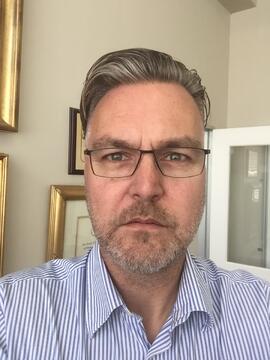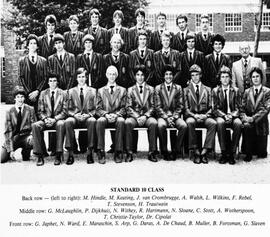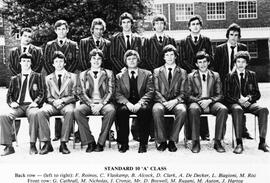Interview with George Daras 1980
- ZA ZAR STDS 202000786
- Unidad documental simple
- 2012
Interview with George Daras – 1980
George was initially a pupil at Yeoville Boys Primary and came to St David’s in standard 1. His
brother Chris was 4 years ahead of him and a boarder whereas George was a day boarder. At
the time there were a lot of pupils who came from Zaire, Zambia, Malawi, Mozambique and from
outlying areas of South Africa and, as a result the school was very strong in sport, sadly when
the boarding closed this was no longer true.
Mrs Watson was his first teacher in the primary school and in the high school he remembers
Mrs Elliott the English teacher who was involved in the running of the school and the matrics. In
standard 6 and 7 he had Mr Maritz who taught History, everyone was terrified of him and didn’t
dare talk in his class. Other teachers were too soft and the boys took advantage were very
naughty and used to chase teachers into a corner with their desks. Mrs Richardson was very
attractive and everyone wanted to be in her class. The teachers were generally very good and
the boys learnt a lot, in fact Damelin poached many of the teachers from St David’s. Damelin
had a good reputation and was renowned for getting good marks. Mr Lipschitz who was a
superb Maths teacher eventually went to Damelin, he was so good that even boys who didn’t
like the subject grew to love it and many ended up as engineers. Mr Lipshitz introduced
basketball to the school as he was a former Springbok. There were few Brothers still at the
school, Br Bernard who was still teaching, Br Aidan the bursar and Br Timothy the headmaster.
George recalls that only one boy at the time wanted to become a Brother.
St David’s was the first school to admit black children in 1975, this was previously unheard of.
George enjoyed sport at the school, it was compulsory in the high school but not so rigorously
enforced in the prep. In the winter the sport was rugby and in the summer athletics, swimming
and cricket, there was no hockey or soccer in those days. Tennis was an additional sport as
was water polo. In standard 4 the boys started to play rugby and played for the U13’s as the C
team which also helped them integrate with the high school boys. The coach, Mr Stringer was
an Englishman and very strict and, in their first game against KES, St David’s beat them 42-0.
They were a very strong team but when they went into high school things changed as they
didn’t have the coaching required although Br Timothy felt that sport was very important and
good for the school’s reputation.
George was captain of the 1st rugby team, also the 2nd team and led the first team ever to go on
tour to Durban to compete against St Henrys’ and St Charles and was awarded an honours
blazer for rugby, merit and study. One of the boy’s fathers worked for BP and organised an
outside rugby coach, a former Springbok and the boys benefitted from the different mind-set. He
led the first team in 6 or 7 years to win more than 4 games in one year. He recalls that the
traditional rivalry with Obs was very strong.
St David’s battled against the bigger schools especially in rugby and George, as head boy in his
matric year took up the matter with Br Timothy when he returned from Australia. The boys felt
demoralised as they were always losing to the bigger schools. Mrs Elliott got involved and
wanted to establish a kind of students representative council to improve communication
between the boys and staff. During the first 6 months of 1980, whilst Br Timothy was away,
George found it difficult to control the matrics as he didn’t have Br Timothy’s back-up. Br
Timothy used to walk around with a cane but allowed the matric boys for the first time to remove
their ties in the summer.
Traditionally, if you were in trouble you were invited to the prefects tea where they would decide
on the appropriate discipline for the crime. When George first arrived at St David’s the younger
boys were terrified of the prefects and punches were dished out freely by them.
George’s matric dance was the first year that the standards 9’s prepared the decorating of the
hall and were invited to attend. The theme was of a gangster/mafia type. Movies were run on a
Friday night to raise funds for the dance and were very popular. Parents came to collect the
boys after the movies and, whilst they were waiting to be collected they were often quite rowdy
and disturbed the Brothers sleep.
Academically George did well and throughout his school career came first or second in his
class.
George achieved the matric results he was aiming for and was admitted to Wits University
where he studied engineering and graduated with a masters degree in industrial engineering.
He enjoyed working with his father making radios and stayed in the same environment and now
owns his own factory undertaking contract work in aircraft design.
George is the father of 3 daughters who are pupils at the Saheti school. He has not attended
any MOBS events but was a member of the audience of the prep school play covering the
history of St David’s in 2011. His brother Chris’s two sons are pupils at St David’s.
Geoorge remembers that there were a number of big families with children at St David’s, the
Lebos, Kourie and Saad families and contemporaries such as Costa Pantelias now living in
Greece, Mark Nicholas, Robert Hartman of Hartman and Keppler; Garth Japhet who went into
medicine and now heads an NGO in Gauteng; Brian Muller a doctor in Jhb; Enrico Maraschin a
gynaecologist at Morningside Clinic; Peter Wharton-Hood, a director of Standard Bank and a
number of other SA companies and Jeffrey Slavin.
George would definitely buy a copy of the book when it is published and would be willing to
make a pledge towards the cost. He also felt it would be fantastic to have the yearbooks
available on the school’s website.
Egenrieder, Julie



